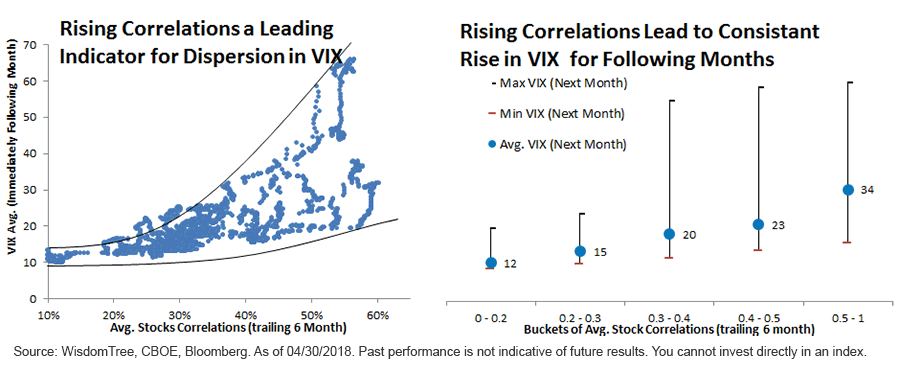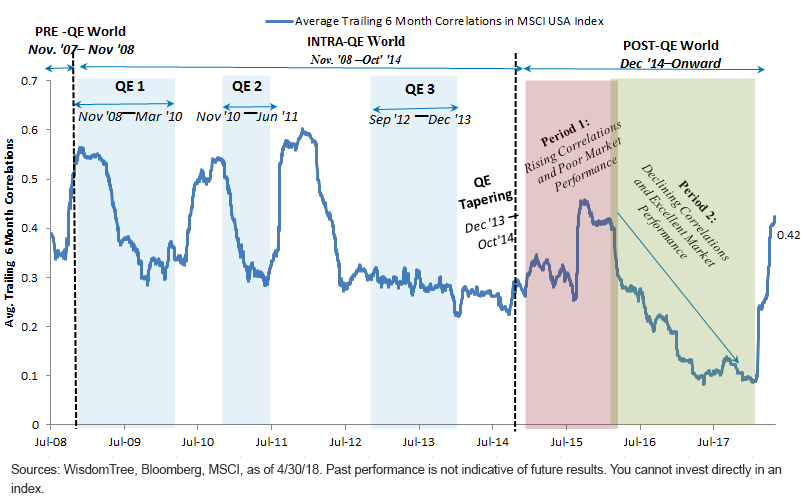WisdomTree launched its first ETFs in June of 2006, pioneering the concept of fundamental weighting. WisdomTree sponsors distinct ETFs that span asset classes and countries around the world.
Interplay of Correlations, Volatility & Positioning in Current Markets
Most experienced investors understand that lack of variability doesn’t necessarily equate to stability. In 2017 the Cboe Volatility Index (VIX) averaged around 10, which is almost half its long-term average. So far this year, VIX has averaged close to 17.5, including a massive 100% spike on February 5—a once-in-almost-200-years event on a statistical basis! 1 Call it a reversal to normal standards or something else, but my analysis below shows that a higher VIX is likely here to stay for some time.
I recently covered how increasing stock correlations were a leading indicator of this spike in VIX and how our proprietary model suggested risk off in February. However, even more interesting questions remain: Is there a leading relationship between stock correlations and VIX? And if s o, what does it tell me for my asset allocation?
Unusual Acceleration in Stock Correlations
Most asset allocation exercises aim for diversification, seeking a lower systematic or market risk. Typically, such diversification in normal markets can be achieved to an extent by a broad stock-selecting strategy. For instance, investing in a broad, diversified index strategy is typically better than taking a concentrated position in fewer names. Of course, diversification does not eliminate the risk of experiencing investment losses.
Now, let’s see how easy it is to achieve diversification in the current regime by analyzing stock correlations in the U.S. The exhibit below plots the average of all possible pairwise trailing six-month correlations of equities in the MSCI USA Index . As I covered in my aforementioned blog post, in a post- quantitative easing (QE) world, correlations have generally been declining. However starting in mid-January of this year, there has been a very sharp acceleration in stock correlations. Arguably, therefore, merely allocating to stocks in the current regime is posing a challenge in de-risking systematic risk.
Significant Pickup in Average Stock Correlations
Next, let us see how this has played out this year and how it has been spooking VIX as well as equity markets.
Accelerating Correlations: A Canary in a Coal Mine?
When I analyze further, it seems average correlations have a predictive power to VIX. In the left exhibit below, we again have our average pairwise stock correlations (trailing six months) across all equities in the MSCI USA Index on the x-axis and average VIX levels in the month that followed on the y-axis.

Two patterns are immediately obvious
1. Higher correlations across equities led to higher VIX levels the following month. Thus, rising correlations act as a signal of higher VIX in the future.
2. Higher correlations in equities also led to a big dispersion in VIX ranges (again in the following month).
To summarize, accelerating correlations not only act as a forerunner for spikes in VIX but also indicate potential wild swings in VIX.
Conclusion
This all leads to few conclusions:
- After years of low correlations in a post-QE world, we are now entering a regime where higher correlations are feeding higher volatility . In my view, higher volatility (compared to 2017) is here to stay.
- Increasing stock correlations within equities are additionally making it harder for investors to look for diversification by simply investing in equities. Thus, beating markets through simple stock selection is getting harder.
Therefore, strategies that seek to generate income by selling volatility (i.e., writing options ), such as WisdomTree’s CBOE S&P 500 PutWrite Strategy Fund (PUTW) , deserve attention. Not only can the strategy generate higher potential income if VIX were to stay elevated, but this income can offset some losses if equities were to go through a downturn, especially in a highly correlated and volatile market. Additionally, our long/short strategies, the WisdomTree Dynamic Long/Short U.S. Equity Fund (DYLS) and the WisdomTree Dynamic Bearish U.S. Equity Fund (DYB) , which opportunistically hedge and seek to provide market-neutral DYLS to bearish DYB experience in markets where fundamentals are deteriorating, can help investors by providing diversifying exposure in declining markets.
Finally, irrationality of markets is hard to predict, and the above indicators should not be taken as a complete equity sell-off signal. The indicators suggest it is worth blending equities with lower-equity beta risk and market-neutral strategies. Such asset allocations may provide investors with better diversification and could defensively posture their portfolios in current volatile markets.
1 Sources: CBOE, Bloomberg, as of 4/30/18.
RSS Import: Original Source
Investors should carefully consider the investment objectives, risks, charges and expenses of the Funds before investing. U.S. investors only: To obtain a prospectus containing this and other important information, please call 866.909.WISE (9473), or click here to view or download a prospectus online. Read the prospectus carefully before you invest. There are risks involved with investing, including the possible loss of principal. Past performance does not guarantee future results.
You cannot invest directly in an index.
Foreign investing involves currency, political and economic risk. Funds focusing on a single country, sector and/or funds that emphasize investments in smaller companies may experience greater price volatility. Investments in emerging markets, real estate, currency, fixed income and alternative investments include additional risks. Due to the investment strategy of certain Funds, they may make higher capital gain distributions than other ETFs. Please see prospectus for discussion of risks.
WisdomTree Funds are distributed by Foreside Fund Services, LLC, in the U.S. only.


